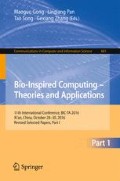Abstract
The working operation problem is an old problem that it is difficult to effectively solve the combinatorial mathematics. So far this problem has not been completely effectively solved, and it is an non-deterministic polynomial (NP)-complete problem. This paper mainly uses the probe machine model and combines the advantages of the nanometer-material to design a computing model for the working operation problem. It structures a database of the vertex and edge, then encodes as a probe library. Using computing platforms to get the solution to be tested, and finding all vertices of the directed Hamilton path which is the solution of the problem. The probe machine is a parallel computing model starting from the bottom; thereby it can improve the effectiveness of the calculation in theory.
Access this chapter
Tax calculation will be finalised at checkout
Purchases are for personal use only
References
Xu, J.: Probe machine. IEEE T. Neur. Net. Lear. 27(7), 1405–1416 (2016)
Turing, A.: On computable numbers, with an application to the Entscheidungsproblem. P. Lond. Math. Soc. 2(1), 230–265 (1937)
Zhang, C., Yang, J., Xu, J.: Self-assembly of DNA/nanoparticles molecular logic calculation model. Chin. Sci. Bull. 27, 2276–2282 (2011)
Xu, J., Li, Z.P., Zhu, E.Q.: Research progress of maximum plane graph theory. Chin. J. Comput. 8, 1680–1704 (2015)
Huang, X.H., Yin, Z.X., Zhi, L.Y.: Molecularbeacon based on DNA computing model for 0–1 programming problem. In: Bio-inspired Computing, pp. 1–5 (2009)
Shi, X., Wang, Z., Deng, C., Song, T., Pan, L., Chen, Z.: A novel bio-sensor based on DNA strand displacement. PloS ONE 9(10), e108856 (2014)
Shi, X., Chen, C., Li, X., Song, T., Chen, Z., Zhang, Z., Wang, Y.: Size controllable DNA nanoribbons assembled from three types of reusable brick single-strand DNA tiles. 11(43), 8484–8492 (2015)
Shi, X., Wu, X., Song, T., Li, X.: Construction of DNA nanotubes with controllable diameters and patterns by using hierarchical DNA sub-tiles. Nanoscale. doi:10.1039/C6NR02695H
Acknowledgment
This work is supported CNSF (Grant number: 61672001).
Author information
Authors and Affiliations
Corresponding author
Editor information
Editors and Affiliations
Rights and permissions
Copyright information
© 2016 Springer Nature Singapore Pte Ltd.
About this paper
Cite this paper
Yang, J., Yin, Z. (2016). The Working Operation Problem Based on Probe Machine Model. In: Gong, M., Pan, L., Song, T., Zhang, G. (eds) Bio-inspired Computing – Theories and Applications. BIC-TA 2016. Communications in Computer and Information Science, vol 681. Springer, Singapore. https://doi.org/10.1007/978-981-10-3611-8_6
Download citation
DOI: https://doi.org/10.1007/978-981-10-3611-8_6
Published:
Publisher Name: Springer, Singapore
Print ISBN: 978-981-10-3610-1
Online ISBN: 978-981-10-3611-8
eBook Packages: Computer ScienceComputer Science (R0)

